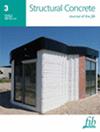从砖废料和偏高岭土中提取高性能土工聚合物:碱处理优化、相变和性能分析
IF 3.3
3区 工程技术
Q2 CONSTRUCTION & BUILDING TECHNOLOGY
引用次数: 0
摘要
本研究介绍了一种利用红砖废料(RBW)和偏高岭土(MK)作为二氧化硅和氧化铝前体生产硅酸铝材料的经济有效且环保的方法。对红砖废料进行碱性熔融,以增加其溶解度,从而进行土工聚合反应。采用响应面方法研究了 NaOH 浓度和熔融温度对从 RBW 中浸出二氧化硅和氧化铝的影响。使用 X 射线衍射和傅立叶变换红外光谱分析了碱熔 RBW 的微观结构。响应面方法学证实并揭示了较高的 NaOH 浓度(14 M)和 660°C 的温度有利于溶解相的形成,从而使二氧化硅和氧化铝的浸出率分别达到 85% 和 50%。然后,利用这些优化参数,以 NaOH 和 Na2SiO3 作为碱性溶液,制备出不同比例的碱熔 RBW 和 MK 土工聚合物材料。使用各种技术对制备的土工聚合物粘合剂进行了表征,如 X 射线衍射(DRX)、傅立叶变换红外光谱(FTIR)、扫描电子显微镜(SEM)、热导率(λ)和耐火性。结果表明,与传统水泥材料相比,含有 30 wt.% 碱熔融 RBW 的土工聚合物具有良好的机械和隔热性能。然而,过量添加 RBW 会产生负面影响。此外,研究还发现,由于存在未反应的 NaOH,混合土工聚合物的热释放率(HRR)增加,导致耐火性降低。总之,这些研究结果证实了可持续利用 RBW 部分替代土工聚合物中的 MK 作为建筑材料的潜力。本文章由计算机程序翻译,如有差异,请以英文原文为准。
High‐performance geopolymer from brick wastes and metakaolin: Alkali treatment optimization, phase transformation, and property analysis
This study presents a cost‐effective and eco‐friendly method to produce aluminosilicate materials using red brick waste (RBW) and metakaolin (MK) as silica and alumina precursors. RBW was subjected to alkaline fusion to increase its dissolution for geopolymerization reaction. Response surface methodology was used to investigate the effect of NaOH concentration and fusion temperature on the leaching of silica and alumina from RBW. The microstructure of the alkali‐fused RBW was analyzed using x‐ray diffraction and Fourier‐transform infrared spectroscopy. Response surface methodology confirmed and revealed that higher NaOH concentration (14 M) and a temperature of 660°C favored solubilized phase development, resulting in 85% and 50% leached silica and alumina, respectively. These optimized parameters were then employed to prepare geopolymer materials with different proportions of alkali‐fused RBW and MK, using NaOH and Na2 SiO3 as the alkaline solution. The elaborated geopolymer binders were characterized using various techniques such as x‐ray diffraction (DRX), Fourier‐transform infrared spectroscopy (FTIR), scanning electron microscopy (SEM), thermal conductivity (λ ), and fire resistance. The results showed that geopolymers containing 30 wt.% of alkali‐fused RBW exerted good mechanical and thermal insulation properties compared to conventional cement materials. However, excessive RBW addition causes negative effects. In addition, it was found that the blended geopolymers exhibited an increase in heat release rate (HRR), resulting in reduced fire resistance due to the presence of unreacted NaOH. Overall, these findings confirmed the potential sustainable use of RBW to partially replace MK in geopolymer as a material for building construction.
求助全文
通过发布文献求助,成功后即可免费获取论文全文。
去求助
来源期刊

Structural Concrete
CONSTRUCTION & BUILDING TECHNOLOGY-ENGINEERING, CIVIL
CiteScore
5.60
自引率
15.60%
发文量
284
审稿时长
3 months
期刊介绍:
Structural Concrete, the official journal of the fib, provides conceptual and procedural guidance in the field of concrete construction, and features peer-reviewed papers, keynote research and industry news covering all aspects of the design, construction, performance in service and demolition of concrete structures.
Main topics:
design, construction, performance in service, conservation (assessment, maintenance, strengthening) and demolition of concrete structures
research about the behaviour of concrete structures
development of design methods
fib Model Code
sustainability of concrete structures.
 求助内容:
求助内容: 应助结果提醒方式:
应助结果提醒方式:


